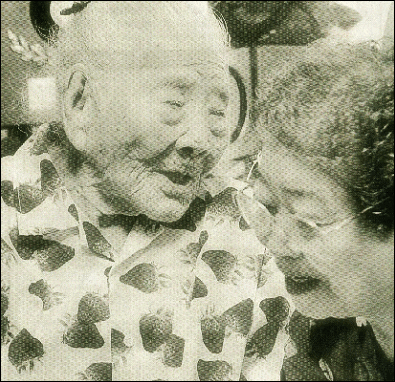Getting to the bottom of ageing
Dato' Dzulkifli Abd Razak
Article
- Demography - New Sunday Times - 11/23/2003
ON the last day of October 2003, the world’s oldest known woman died at the age of 116. Barely a month before, the oldest documented man died at the age of 114.
Both were Japanese, symbols of the nation’s grey population with many centenarians among them.
In fact, in Japan, “Respect for the Aged Day" is a national holiday to recognise those who have reached their 65th birthday, and this involves almost one in five.
According to UN’s Population Division, in 2000 Japan ranked fourth in the list of world's "oldest” countries with 17 per cent of its population 65 years and above.
Italy topped the list with 18.1 per cent followed by Greece and Sweden, both at 17.3 per cent, (IHT, July 12-13).
By 2030, Europe would be the "oldest", with 30.2 per cent of its population 60 and above, followed by North America (25 per cent), Oceania (21.1) and Asia (16.8).
Article
- Demography - New Sunday Times - 11/23/2003
ON the last day of October 2003, the world’s oldest known woman died at the age of 116. Barely a month before, the oldest documented man died at the age of 114.
Both were Japanese, symbols of the nation’s grey population with many centenarians among them.
In fact, in Japan, “Respect for the Aged Day" is a national holiday to recognise those who have reached their 65th birthday, and this involves almost one in five.
According to UN’s Population Division, in 2000 Japan ranked fourth in the list of world's "oldest” countries with 17 per cent of its population 65 years and above.
Italy topped the list with 18.1 per cent followed by Greece and Sweden, both at 17.3 per cent, (IHT, July 12-13).
By 2030, Europe would be the "oldest", with 30.2 per cent of its population 60 and above, followed by North America (25 per cent), Oceania (21.1) and Asia (16.8).

Record hoder: 116-year-old Kamato Hongo (left) at her home in Kagoshima, Japan. Hongo, who entered the Guinness Book of Records as the olders person in the world, died on Oct 31. - AFP picture
By 2050, it is estimated that more than a quarter of the world’s population would be considered elderly. This is a marked contrast to what it was 100 years ago.
Then, living beyond just 50 was considered a major achievement, particularly in the developing world. Today, on average, life expectancy globally has moved up from about 30 years to over 65.
For some, ageing is a source of wisdom and pride; for others, of fear and concern. Still others dream of the “elixir of youth" in the hope to beat the "Father Time", or at least delay ageing.
Legendary Spanish explore Juan Ponce de Leon (1460-1521) went in search of the "fountain of youth" after hearing about it from native Americans.
The spring, whose waters had the power to restore youth was said to be on an island called Bimini, supposedly north of Cuba.
In 1512, de Leon obtained permission from the Spanish king to find the island. But he failed.
The search for "eternal youth" goes on till this day, where people are living longer, thanks to enlightened life styles and the help of science, technology and medicine.
Then, living beyond just 50 was considered a major achievement, particularly in the developing world. Today, on average, life expectancy globally has moved up from about 30 years to over 65.
For some, ageing is a source of wisdom and pride; for others, of fear and concern. Still others dream of the “elixir of youth" in the hope to beat the "Father Time", or at least delay ageing.
Legendary Spanish explore Juan Ponce de Leon (1460-1521) went in search of the "fountain of youth" after hearing about it from native Americans.
The spring, whose waters had the power to restore youth was said to be on an island called Bimini, supposedly north of Cuba.
In 1512, de Leon obtained permission from the Spanish king to find the island. But he failed.
The search for "eternal youth" goes on till this day, where people are living longer, thanks to enlightened life styles and the help of science, technology and medicine.

Longevity: Mitoyo Kawate, 114, living in Hiroshima, became the oldest person in Japan after the death of Kamato Hongo. - Reuters picture
Not only has the demographic profile of the globe changed dramatically, multi-generational families too are becoming common these days.
It is not surprising therefore that the number of centenarians in many Countries is doubling every decade, especially in developed countries.
The number of "supercentenarians" — those 105 years and older — is also becoming larger, and the oldest person in recent times was a French woman who died six years ago at the ripe old age of 122.
The latest forecast is that humans could live up to 150 years old. Part of this optimism is based on the advances in medicine and therapeutics which promise to keep old-age diseases and illnesses at bay by focusing' on disease prevention and geriatric care.
According to Forbes (Oct 27), evidence shows that drugs that can lower the risk of almost every major disease of ageing are just around the corner.
In time, hospital care will be replaced by pharmaceutical care, with billions of dollars spent to produce specific anti-ageing drugs.
These drugs, with anti-inflammatory properties, have been developed thanks to the so-called “inflammaging” theory.
There are claims that exercising and losing weight may give similar effects to the anti-inflammatory medicines, minus the side-effects.
Thus, together with better and healthier diets (for example, traditional Japanese diet, which is low in fatty foods), and cleaner habits (such as regular exercise and being free of tobacco and drugs), attaining longevity is within reach.
A close re-examination of the first half of the 1900s, indicates that the vast improvement in life expectancy can be influenced by public health reasons, such as better sanitation facilities and practices.
Concurrently, improved general living conditions as well as workplace environment underscored the point that longevity is dependent on a variety of factors acting in consonant with each other.
Ironically, given the success of the Human Genome Project, the notion of "fountain of youth" is surfacing yet again, albeit in a different form.
This time, by being able to better understand why human cells begin to senesce (age) — a critical step in the "control" of the human ageing process (senescence) — the power to restore youth may be possible.
To date, researchers have identified at least three genes that are involved with ageing. And more recently, genetic variants in male centenarians have been identified indicating that pro-inflammatory effects of ageing could be mitigated.
With the coming to age of embryonic stem cell technology, the elusive "fountain of youth" may be within reach as the mystery of the exact causes and mechanisms of ageing get unravelled.
It is in this context that Malaysia, a relatively a young country, must not take its youthfulness for granted in achieving greatness.
Much more could be achieved by staying healthy, active and productive.
For Muslims in particular, the benefits of restraints learnt during Ramadan should make them more aware of physical, mental and spiritual well being.
In the coming festive seasons, we must reaffirm our respect and care for the elderly and aged by inculcating such noble values in our daily lives.
Wishing Muslim readers Selamat Hari Raya, maaf zahir batin.
It is not surprising therefore that the number of centenarians in many Countries is doubling every decade, especially in developed countries.
The number of "supercentenarians" — those 105 years and older — is also becoming larger, and the oldest person in recent times was a French woman who died six years ago at the ripe old age of 122.
The latest forecast is that humans could live up to 150 years old. Part of this optimism is based on the advances in medicine and therapeutics which promise to keep old-age diseases and illnesses at bay by focusing' on disease prevention and geriatric care.
According to Forbes (Oct 27), evidence shows that drugs that can lower the risk of almost every major disease of ageing are just around the corner.
In time, hospital care will be replaced by pharmaceutical care, with billions of dollars spent to produce specific anti-ageing drugs.
These drugs, with anti-inflammatory properties, have been developed thanks to the so-called “inflammaging” theory.
There are claims that exercising and losing weight may give similar effects to the anti-inflammatory medicines, minus the side-effects.
Thus, together with better and healthier diets (for example, traditional Japanese diet, which is low in fatty foods), and cleaner habits (such as regular exercise and being free of tobacco and drugs), attaining longevity is within reach.
A close re-examination of the first half of the 1900s, indicates that the vast improvement in life expectancy can be influenced by public health reasons, such as better sanitation facilities and practices.
Concurrently, improved general living conditions as well as workplace environment underscored the point that longevity is dependent on a variety of factors acting in consonant with each other.
Ironically, given the success of the Human Genome Project, the notion of "fountain of youth" is surfacing yet again, albeit in a different form.
This time, by being able to better understand why human cells begin to senesce (age) — a critical step in the "control" of the human ageing process (senescence) — the power to restore youth may be possible.
To date, researchers have identified at least three genes that are involved with ageing. And more recently, genetic variants in male centenarians have been identified indicating that pro-inflammatory effects of ageing could be mitigated.
With the coming to age of embryonic stem cell technology, the elusive "fountain of youth" may be within reach as the mystery of the exact causes and mechanisms of ageing get unravelled.
It is in this context that Malaysia, a relatively a young country, must not take its youthfulness for granted in achieving greatness.
Much more could be achieved by staying healthy, active and productive.
For Muslims in particular, the benefits of restraints learnt during Ramadan should make them more aware of physical, mental and spiritual well being.
In the coming festive seasons, we must reaffirm our respect and care for the elderly and aged by inculcating such noble values in our daily lives.
Wishing Muslim readers Selamat Hari Raya, maaf zahir batin.
